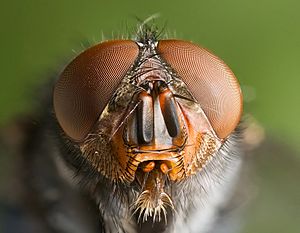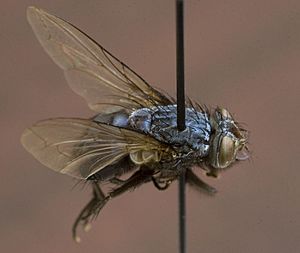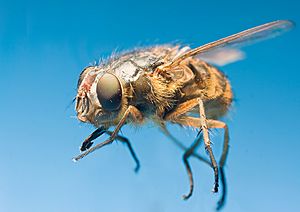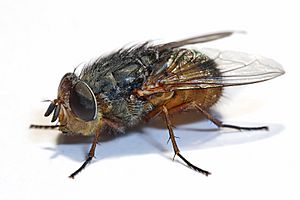Calliphoridae facts for kids
Quick facts for kids Calliphoridae |
|
|---|---|
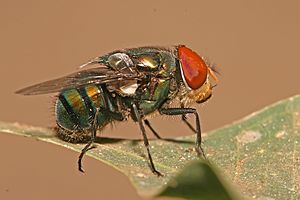 |
|
| Male Chrysomya megacephala | |
| Scientific classification |
|
| Kingdom: | Animalia |
| Phylum: | Arthropoda |
| Class: | Insecta |
| Order: | Diptera |
| Superfamily: | Oestroidea |
| Family: | Calliphoridae Brauer & Bergenstamm, 1889 |
| Subfamilies | |
|
|
The Calliphoridae are a group of insects commonly known as blow flies. You might also hear them called bluebottles, greenbottles, or cluster flies. They are a family of flies, and there are about 1,200 different kinds, or species, known around the world.
The young forms of blow flies, called maggots or "gentles," are often used by people for fishing bait. The name "blow fly" comes from an old English term for meat that had fly eggs laid on it, which was called "fly blown." The famous writer William Shakespeare used this term in some of his plays!
Contents
What Do Blow Flies Look Like?
Shiny Colors and Special Features
Adult blow flies are usually shiny and have metallic colors. They can be blue, green, or black, especially on their main body parts like the thorax and abdomen.
They have three-part antennae with a feathery bristle called an arista that runs along its whole length. This feathery arista is one way to tell them apart from other flies.
How Scientists Identify Blow Flies
Scientists look at the tiny hairs, called bristles, on a blow fly's body to figure out what kind it is. All blow flies have special bristles on a part of their leg called the meron. They also have two bristles on their notopleural area (part of the thorax) and a specific bristle behind their shoulder. These small details help experts identify different blow fly species.
The middle part of their body, the thorax, has a line across the top. Their wings have a strong front edge that doesn't break, and another vein that is easy to see.
What Do Blow Flies Eat?
Adult blow flies sometimes help pollinate flowers. They are drawn to flowers that smell like rotting meat, such as the American papaw or dead horse arum. They likely drink nectar from these flowers for energy to fly.
Most blow fly larvae (maggots) are scavengers. This means they eat dead animals (carrion) or animal waste (dung). They are often the main type of maggot you find in these materials.
Who Eats Blow Flies?
Many animals like to eat blow flies! Their predators include spiders, beetles, frogs, and birds, including chickens.
Where Do Blow Flies Live?
There are about 1,100 known species of blow flies. Many of them live in warmer, tropical areas, especially in Africa and Southern Europe.
Blow flies usually prefer places that have loose, damp soil and leaf litter. This is because their larvae need these conditions to grow and turn into adult flies.
Types of Blow Flies
There are many different types of blow flies. Here are some examples of the groups, or genera, found in different parts of the world:
- Calliphora
- Chrysomya
- Lucilia
- Phormia
Why Are Blow Flies Important?
Myiasis: When Flies Cause Problems
Blow flies are very interesting to scientists because they can sometimes cause a problem called myiasis. This happens when fly larvae, or maggots, grow inside living animals or humans.
For example, the sheep blow fly (Lucilia cuprina) causes a lot of trouble for sheep farmers in Australia, costing them millions of dollars each year.
If myiasis happens in humans, the maggots are usually very young. The simple treatment is to remove the maggots, and the person usually heals well. There's also a special type of maggot called the Congo floor maggot that feeds on the blood of mammals, including humans.
Screwworms: A Major Pest
Some blow flies are known as screwworms. The New World primary screwworm (Cochliomyia hominivorax) used to be a big problem in the southern United States. However, it was removed from the U.S., Mexico, and Central America through a special program. This program released male screwworms that couldn't have babies, which helped control the population.
The Old World primary screwworm (Chrysomya bezziana) is a parasite that must live on mammals. It's found in many parts of the Old World, including Africa and Southeast Asia.
Another type, the secondary screwworm (Cochliomyia macellaria), is very important in forensic science.
Maggot Therapy: Maggots as Medicine
Believe it or not, some maggots are used in medicine! This is called maggot debridement therapy (MDT). Doctors use special, clean maggots grown in a lab to clean wounds that aren't healing well. The maggots only eat dead tissue, leaving the healthy tissue alone.
The common green bottlefly (Lucilia sericata) is often used for this therapy. MDT can help treat different types of wounds, like pressure sores or diabetic foot wounds.
Can Blow Flies Spread Diseases?
Adult blow flies can sometimes carry and spread germs that cause diseases, like dysentery. They have been linked to spreading bacterial infections in both humans and animals.
When flies land on decaying bodies, they lay eggs. The maggots hatch and start eating the body. If there are harmful microorganisms (like bacteria) in the body, the maggots can pick them up. This is one way diseases can spread.
For example, a bacterium that causes a disease in cattle, pigs, and birds has been found in blow flies.
Blow flies can also cause a skin problem called flystrike in sheep. This happens when blow flies lay eggs in a wound or dirty wool on a sheep. When the maggots hatch, they feed on the sheep's skin, causing irritation and lesions. If it's bad enough, it can even kill the sheep. Farmers use insecticides and good animal care to prevent this.
Another disease, Salmonellosis, can be spread by blow flies through their saliva, waste, or by direct contact with their feet. Because flies can carry so many germs, it's important to understand how they spread diseases and how to prevent them.
How Blow Flies Help Solve Mysteries
Blow flies are usually the very first insects to find a dead body. They can smell dead animals from far away, sometimes even a mile (about 1.6 kilometers) away! Once they find a body, the female flies lay their eggs on it.
Because scientists know how quickly blow fly maggots grow at different temperatures, these flies are a very useful tool in forensic science. They help experts figure out how long a person has been dead, especially after 72 hours, when other methods become less reliable. This special field is called forensic entomology.
Besides helping to estimate the time of death, blow flies found on a body can also help detectives figure out if the body was moved from one place to another after death.
Some important blow flies used in forensic science include Calliphora vicina, Phormia regina, and Lucilia sericata.
Images for kids
See also
 In Spanish: Califóridos para niños
In Spanish: Califóridos para niños


